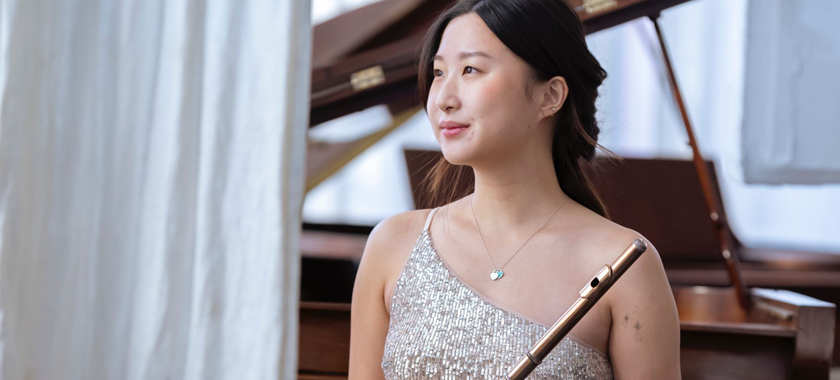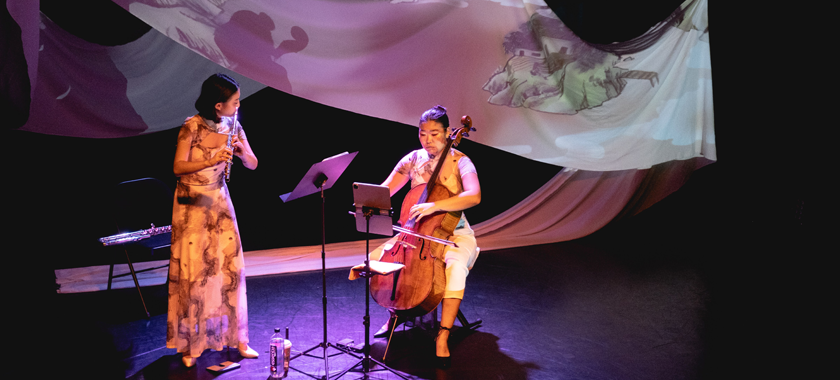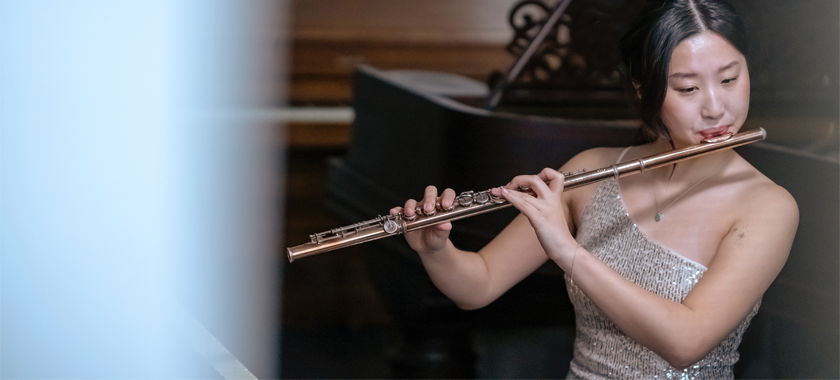
How to Write a Love Letter: A Conversation with Eva Ding
Ding talks about the process of locating opportunities when making “For Mum, Dad,” a multimedia chamber music show and a love letter to immigrant parents.
Flutist and multi-disciplinary artist Eva Ding’s (IAP Mentee ’19) “For Mum, Dad” melds together her passions for music, theater, and film. Here, Ding shares how she develops new work, finds collaborators, and where she looks for resources to grow her arts career and navigate the arts industry.
New York Foundation for the Arts (NYFA): Your project “For Mum, Dad” had a multi-day run at Arts On Site in November and was funded by the LMCC Creative Engagement Fund. Tell us about the project and your process locating opportunities for this project.
Eva Ding (ED): “For Mum, Dad” is a multimedia chamber music show that had been an idea in my mind for a while. I was lucky enough in November of 2021 to hold an artist residency at the Center at West Park to use the space for two weeks and explore, create, and make that idea become a reality. The residency culminated in a three-night run in that space with a small team of musicians and production/artistic crew. The basic idea of the show is that it’s a love letter—an homage—to immigrant parents and the sacrifices they make so that their children can have a better future. It is something that’s very near and dear to my heart, being a child of immigrants.
The basic idea of the show is that it’s a love letter—an homage—to immigrant parents and the sacrifices they make so that their children can have a better future.
-Eva Ding
I, along with my duo chamber partner Emma Kato and guest artist April Sun, played music by all composers of Asian heritage, including Zhou Long, Lei Liang, Chen Yi, and premiered new works by up-and-coming composers Corey Chang and Yuki Ohnishi. We collaborated with visual artists, including Regina Linke (who does the Oxherd Boy comics), who created visuals that were projected behind us as we played. The visuals took us on an immigrant’s journey—from leaving their old home, to traveling to new and unfamiliar lands, to finally settling into their newfound home.
This year, I received the Creative Engagement Grant from the Lower Manhattan Cultural Council (LMCC) to put on a 2.0 version of that show. For this iteration of the show, we explored the idea of what it means to call a place “home,” and got to collaborate with incredible new media artist Xuan who created a rich tapestry of images and media that played while we performed works by Andy Akiho, Yuko Uebayashi, Lei Liang, Chen Yi, and premiered two new pieces written again by Corey Chang and Yuki Ohnishi. We wanted to bring more of a set/textural element to the space this time, so we fashioned a swath of material that hung from the ceiling and swept its way down and around the stage, where the projections were then beamed onto.
I’ve been lucky enough that some of the venue connections have been through mutual friends, and a lot of the other opportunities have just been persistent online searching, applying, and getting many, many “no’s” before getting a single ‘yes’. Luckier still, I’d say, is that the collaborators I’ve worked with have often been people I’ve just reached out to, be that via email, on social media, or in person, with an idea or a passion project—and they’re often immediately on board because it’s something they’re equally as passionate about.
The collaborators I’ve worked with have often been people I’ve just reached out to, be that via email, on social media, or in person, with an idea or a passion project—and they’re often immediately on board because it’s something they’re equally as passionate about.
-Eva Ding

NYFA: What makes a collaboration productive and rewarding?
ED: Collaboration is at the core of everything I do, whether that be collaborating with my musical partner/s, or with other artists in different fields, or with composers who we commission the works of. For example, this past summer, my duo KOE and Corey Chang were at an artist residency in New Hampshire. We essentially lived together for two weeks in a sprawling converted farm and really got to know each other through working with each other in close proximity, reading through Corey’s draft compositions together, and dining and playing pool together.
A few months later, Corey wrote a piece for us that distilled our individual personalities and duo character so perfectly in three movements of music. How lucky and honored are we that someone has created works that may be performed by others in the future that came from our collaboration with them. I think one of the most rewarding things about working with others is when I get to collaborate with folks who share the same values and vision I do, and the collaborations that really have longevity are the ones that form out of or develop into lifelong friendships.
Additionally, one of my biggest endeavors in my creative practice is to meld together classical music, theatrical arts, and new media to create and program multi-sensory experiences with overarching themes that are meaningful to me and to my communities. To me, growing up partly a theater kid, I’ve seen how set design, lighting, costumes, and more can elevate a performance experience and I want to bring that level of collaboration between the arts to classical music. In that way, I believe we’ll be illuminating classical music in a way that is exciting and interesting for a new audience—one that better reflects the world around us.
To me, growing up partly a theater kid, I’ve seen how set design, lighting, costumes, and more can elevate a performance experience and I want to bring that level of collaboration between the arts to classical music.
-Eva Ding
NYFA: You were a mentee of both NYFA’s IAP Mentoring Program (Performing & Literary Arts 2019) and bespoken, a mentorship program for women in classical, contemporary, and jazz music. Can you speak about the impacts of being in a mentoring relationship?
ED: Absolutely—the wisdom and insight gained from my mentors, who are in different career and life stages than me, in both of these programs and other mentoring programs I’ve been involved in, has really been invaluable. I feel like a mentoring relationship helps keep you accountable and supported without the strictness of feeling like you’re being graded.
Furthermore, in every mentoring program I’ve been a part of, what also stood out to me was the way that the cohort of mentors and mentees supported and uplifted each other and the fact that the organizations running the mentorship program were so willing to provide extra resources or help.

NYFA: What resources have you found helpful when it comes to learning about how to grow careers in the performing arts field and navigating the industry?
ED: I think in this digital age, if you care to research, the world really is your oyster! Sites like the NYFA website, Pick Up The Flow, and many others that compile grants, residency, and even job opportunities are wonderful resources. Local organizations that support the creation of arts based in specific cities or even boroughs are also great resources. Additionally, looking at artists whose career paths inspire you and what kind of programs or residencies they may have been a part of and seeing if those are applicable to you may be helpful!
About Eva Ding:
Flutist and multi-disciplinary artist Eva Ding creates interactive, interdisciplinary works that meld together her passions for music, theater, and film—the most current of which was funded by the Lower Manhattan Cultural Council (LMCC) Creative Engagement Grant.
Often humorously likened to an inflatable tube man because of her onstage enthusiasm, passion, and physicality, all Ding wants to do is imbue in her audience the same sense of joy and richness the performing arts brings to her. Ever-changing and growing in her passions and craft, Ding most recently collaborated with and premiered Jon Batiste’s first orchestral piece “American Symphony” at Carnegie Hall. Ding is also an avid proponent of commissioning new works, especially by composers of Asian heritage.
Ding made her concerto debut when she was 14 at the Meet in Beijing Festival. In 2017, she made her New York concerto debut with the Brooklyn Metro Chamber Orchestra. She has also given premiere performances of Tailleferre’s “Concertino,” an orchestral arrangement of Claude Bolling’s “Suite for Flute and Jazz Trio,” and Chen Yi’s “The Golden Flute” concerto. Her most interesting gig to date, however, was when she was the opening musical number for pro-wrestler Orange Cassidy at Independent Wrestling TV’s “Family Reunion” Match.
Outside of her performing practice, Ding is also the Artistic Director of After Arts—a music organization that brings together a community of people with a background in music who now work in finance, law, medicine, tech, and business for cultural activities and outings in the city. Programming includes salons where community members gather with professional musicians for recitals and sight reading parties in luxury apartments across New York. As Artistic Director, Ding has been able to flex her programming muscles to create entire concert seasons for After Arts, making an effort to program lesser known works or composers.
Ding is Shanghai-born, Auckland-raised, and New York-based. She received the Manhattan School of Music President’s Scholarship and completed a Master of Music degree with Robert Langevin, Principal Flute of the New York Philharmonic. She also holds a Bachelor of Music degree with First Class Honors from the University of Auckland, under the tutelage of Professor Uwe Grodd.
–Ya Yun Teng, Program Officer, Immigrant Artist Resource Center (NYC)
This post is part of the ConEdison Immigrant Artist Program Newsletter #153. Subscribe to this free monthly e-mail for artist’s features, opportunities, and events. Learn more about NYFA Immigrant Artist Mentoring Program.